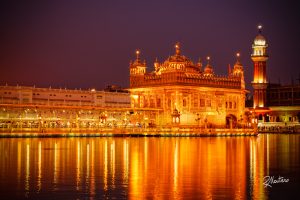66 South Asia: Regional Example – Punjab
The Punjab sub-region of South Asia is territory that is split between Pakistan and India with the borders being established upon the end of the British Empire in South Asia. This region produces rich harvests and is known as the breadbasket of the broader area. The name Punjab is derived the Indo-Iranian terms panj meaning five and āb meaning water. Indeed, five rivers as tributaries of the Indus River system drain through Punjab.
B is for Border
The historical region of Punjab was split into two sections by the Radcliffe Line, the demarcation designed by Cyril Radcliffe for the end of British rule in South Asia. The line divided Pakistan from India, but did not solve all the issues. Radcliffe himself pushed the notion that no border solution would please everyone, but that boundary decisions had to be made. The Sikh population in Punjab was particularly frustrated with the apportionment of Punjab split into two countries. In Political Geography, this type of border is called superimposed, for it places the boundary on top of already established ethnic populations, yet does not align with these ethnicities.
I is for the Indus River

The Indus River is the largest river of Pakistan, but its sources is in China and it traverses part of India as well. Eventually, the Indus reaches the Arabian Sea at the port city of Karachi. There are five rivers that form a dendritic drainage pattern as tributaries of the Indus. The Jhelum, Chenab, Ravi, Sutlej, and Beas Rivers flow like branches in a tree, eventually all the water reaching the Indus River. In the Hydrology sub-category of Physical Geography, this tree and branches structure is termed the dendritic pattern. The Indus River is nearly 2000 miles long. The Indus Water Treaty regulates the river’s use by Pakistan and India.
A is for Agriculture
Success in agriculture is directly connected to “I is for the Indus River,” as irrigation heavily utilized in farming in Punjab. On both sides of the border, about 40% of the population is involved in farming. If not for the rivers of Punjab, this great agricultural region would flounder. Nearly all of the fields in Punjab are irrigated. Irrigated agriculture has been a way of life for many generations in this region. On the Pakistani side of Punjab, the Nara Canal was connected to the Indus River in 1858-1859 and at full length extends 513 miles. In several districts on the Indian side of Punjab, 100% of the fields are irrigated – in Fatehgarh and Jalandhar for instance. Historically, irrigation is through an extensive array of canals that flood the fields; however, modern drip irrigation systems are progressively being implemented, as these systems are more effective for plant growth and more efficient in the use of water. In India, the Punjab region comprises less than 2% of the country’s total area, but typically produces over 20% of the country’s wheat harvest. While irrigation is crucial to agricultural success in Punjab, fertile soils and a two-season growing year also are major factors. Note that so-called winter wheat grows in Punjab, but winter there is not what Midwestern Americans experience as winter. Average winter temperatures in Punjab are in the 60°F range.
S is for Sikh

Although Punjab hosts many ethnic groups and religions, it is noteworthy as the home of the Sikh religion and the population center of modern-day Sikhs. The monotheistic Sikh religion was founded in the 16th century by Guru Nanak in the Punjab region. In Punjabi language, Sikh means disciple. Although the Sikh religion is a peaceful faith, out of necessity of protecting their culture when surrounded by other peoples, faiths, and cultures, Sikhs developed a strong military regimen, eventually serving with distinction in the British military and later in the Indian armed forces.
Here is a summary of Sikh core beliefs.
- There is only one God
- God is without form, or gender
- Everyone has direct access to God
- Everyone is equal before God
- A good life is lived as part of a community, by living honestly and caring for others
- Empty religious rituals and superstitions have no value1
Our acronym for the Punjab region is BIAS. The choice of acronym may have an additional meaning for Sikhs who may feel discrimination when outside of the region or in a foreign country.
Did you know?
Do not confuse the terms Sikh and sheikh. Sheikh is an Arabic word that means leader.
Not counting Punjab, the USA and the UK are essentially tied for the highest Sikh population with roughly 700,000.

Americans somewhat commonly mistake the Sikhs for Arabs. Arab men may wear the keffiyeh as a headdress (somewhat famously by Palestinean leader Yasser Arafat). However, the keffiyeh is not at all the same as the Sikh turban. Sikhs are not Arabs, but are entirely different in ethnicity and culture.
My Turn!
CITED AND ADDITIONAL BIBLIOGRAPHY:
1BBC – Religion: Sikhism. https://www.bbc.co.uk/religion/religions/sikhism/. Accessed 4 July 2022.
Foley, Michael. Indus River Delta. photo, 15 Jan. 2006. Flickr, https://www.flickr.com/photos/michaelfoleyphotography/414191328/. Attribution-NonCommercial-NoDerivs 2.0 Generic (CC BY-NC-ND 2.0).
“Improving Punjab Irrigation: More Crops from Every Drop.” World Bank, https://www.worldbank.org/en/news/feature/2014/04/18/improving-punjab-irrigation-more-crops-from-every-drop.
Mantero, Riccardo Maria. The Golden Temple. photo, 15 Aug. 2016. Flickr, https://www.flickr.com/photos/ljsilver71/30283046092/. Attribution-NonCommercial-NoDerivs 2.0 Generic (CC BY-NC-ND 2.0)
Mosseby, Per. India: Sikh Taxi Driver. photo, 23 Mar. 2005. Flickr, https://www.flickr.com/photos/moz/7276647/. Attribution-ShareAlike 2.0 Generic(CC BY-SA 2.0).
Nabeel, Fazilda. “How India and Pakistan Are Competing over the Mighty Indus River.” Down to Earth, https://www.downtoearth.org.in/news/water/how-india-and-pakistan-are-competing-over-the-mighty-indus-river-63321.
Sikhism Religion of the Sikh People. http://www.sikhs.org/topics.htm.



